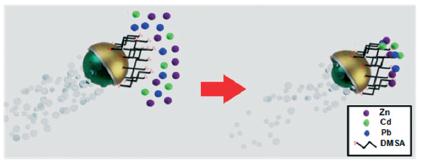Jean-Pierre Sauvage, Fraser Stoddart and Ben Feringa have just been awarded the Nobel Prize in Chemistry for the design and synthesis of molecular machines. Ranging from artificial muscles to micromotors, these nanomachines can perform different tasks and present a myriad of applications. In 1983, Sauvage linked two-ring-shaped molecules by a freer mechanical bond. He was then followed by Stoddart who developed, among other things, a molecule-based computer chip, and more recently Ben Feringa who designed a nanocar. These three remarkable scientists were pioneers in the field and many others now benefit from their contributions to science.
Taking advantage of these findings, Uygun and colleagues developed unique micromotors that offer high-speed metal remediation. Microscale machines have been used for accelerated isolation and degradation of toxins and clean-up of oil-contaminated water, among other uses. The continuous autonomous movement of functionalised nanomachines around a contaminated sample leads to enhanced transport of the remediation agent resulting in greatly accelerated decontamination. However, most of these require external fuel, such as hydrogen peroxide, and expensive catalysts, which then prevents their widespread use. Only recently have new fuel-free Mg-based microparticles been developed. They are highly biocompatible as they use water as their sole fuel. Using these new nanomachines, Uygun describes a Mg Janus-micromotor that is functionalised with meso-2,3-dimercaptosuccinic acid (DMSA), which has been recognised as an excellent chelating agent for heavy metals (Figure 1).
The micromotors were prepared by half-coating magnesium microparticles with Ti and Au layers and the external gold surface was modified by incubation in DMSA. The removal of its passivation layer will expose the Mg surface allowing an Mg-water redox reaction that generates hydrogen microbubbles leading to an efficient water-propulsion. Moreover, a small number of micromotors can lead to a nearly complete removal of heavy metals within a short period of time and they are not impacted by co-existing metal ions present in complex samples, making these nanomachines an interesting and cost effective option for fast removal of heavy metal pollutants.
By developing these self-propelled water-driven molecular machines, Uygun and colleagues are corroborating the Nobel Prize laureates and spreading the belief of the Swedish Academy of Science: “we are at the dawn of a new industrial revolution of the 21st century and the future will show how molecular machinery can become an integral part of our lives”.
To read the full article for free* click the link below:
—————-

About the webwriter
Luiza Cruz is a PhD student in the Barrett Group at Imperial College London. Her work is towards the development of new medicines, using medicinal and natural products chemistry.
*Access is free until 20/11/2016 through a registered publishing personal account.











